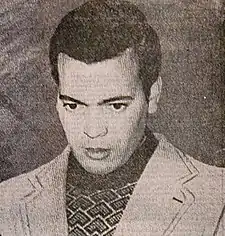Hamida Djandoubi
Hamida Djandoubi (Arabic: حميدة جندوبي; September 22, 1949 in Tunis, Tunisia – September 10, 1977 in Marseilles, France) was a Tunisian sentenced to death in France. He was a Tunisian agricultural worker and convicted murderer. He moved to Marseille, France, in 1968 and six years later he kidnapped, tortured and murdered 22-year-old Élisabeth Bousquet. He was sentenced to death in February 1977 and executed by guillotine in September that year. He was the last person to be executed in Western Europe,[2] and he was the last person to be lawfully executed by beheading anywhere in the Western world. He was not however, the last person sentenced to death in France. Marcel Chevalier served as chief executioner.[3]
Hamida Djandoubi | |
|---|---|
 Hamida Djandoubi, awaiting trial audience, February 1977 | |
| Born | 22 September 1949 |
| Died | 10 September 1977 (aged 27) |
| Cause of death | Execution by guillotine |
| Resting place | Cimetière Saint-Pierre, Marseilles |
| Nationality | Tunisian |
| Other names | "Pimp Killer" |
| Occupation | Landscaper, pimp |
| Criminal status | Executed by guillotine on 10 September 1977 |
| Motive | Revenge for previous criminal charges |
| Conviction(s) | Guilty on all charges (25 February 1977) |
| Criminal charge | Procuring Rape (2 counts) Torture murder Premeditated violence (3 counts)[1] |
| Penalty | Capital punishment (25 February 1977) |
| Details | |
| Victims | Élisabeth Bousquet, 22 |
| Date | Early 1973 (procuring) – 3 July 1974 (murder) |
| Location(s) | Marseilles Lançon-Provence |
Date apprehended | 11 August 1974 |
Early life
Born in Tunisia on 22 September 1949, Djandoubi started living in Marseille in 1968, working in a grocery store. He later worked as a landscaper but had a workplace accident in 1971: his leg got caught in the tracks of a tractor and resulted in the loss of two-thirds of his right leg.[4]
In 1973, a 21-year-old woman named Élisabeth Bousquet, whom Djandoubi had met in the hospital while recovering from his amputation, filed a complaint against him, stating that he had tried to force her into prostitution.[4]
Murder of Élisabeth Bousquet
After his arrest and eventual release from custody during the spring of 1973, Djandoubi drew two other young girls into his confidence and then forced them into prostitution for him.[5] On 3 July 1974, he kidnapped Bousquet and took her into his home where, in full view of the terrified girls, he beat the woman before stubbing a lit cigarette all over her breasts and genital area. Bousquet survived the ordeal so he took her by car to the outskirts of Marseille and strangled her there.[6][7]
On his return, Djandoubi warned the two girls to say nothing of what they had seen.[6] Bousquet's body was discovered in a shed by a boy on 7 July 1974. One month later, Djandoubi kidnapped another girl who managed to escape and report him to police.[8]
Trial and execution
After a lengthy pre-trial process, Djandoubi eventually appeared in court in Aix-en-Provence on charges of torture-murder, rape, and premeditated violence on 24 February 1977. His main defence revolved around the supposed effects of the amputation of his leg six years earlier which his lawyer claimed had driven him to a paroxysm of alcohol abuse and violence, turning him into a different man.
On 25 February he was sentenced to death. An appeal against his sentence was rejected on 9 June. In the early morning of 10 September 1977, twelve days before his 28th birthday, Djandoubi was informed that he, like the child murderers Christian Ranucci (executed on 28 July 1976) and Jérôme Carrein (executed on 23 June 1977), had not received a reprieve from President Valéry Giscard d'Estaing. Shortly afterwards, at 4:40 a.m., he was executed by guillotine at Baumettes Prison in Marseille.
While Djandoubi was the last person executed in France, he was not the last condemned.[9] No more executions occurred after capital punishment was abolished in France in 1981 following the election of François Mitterrand, and those sentenced to die had their sentences commuted.[10] Djandoubi's death would be the final time any Western nation would ever carry out an execution by beheading, as well as the most recent government-sanctioned guillotine execution in the world.
See also
- Nicolas Jacques Pelletier, the first person to be executed by guillotine in France in 1792, during the French Revolution.
Further reading
- Mercer, Jeremy (2008). When the Guillotine Fell: The Bloody Beginning and Horrifying End to France's River of Blood, 1791--1977. Macmillan. ISBN 9781429936088.
- Jean-Yves Le Nahour, Le Dernier guillotiné, Paris, First Editions, 2011
References
- Exécution d'Hamida Djandoubi à Marseille, TF1, September 10, 1977. INA. Retrieved August 31, 2017.
- Franklin E. Zimring (24 September 2004). The Contradictions of American Capital Punishment. Oxford University Press. pp. 33–. ISBN 978-0-19-029237-9.
- Les deux derniers bourreaux français toujours vivants, La Dépêche du Midi, 10 September 2007 (French)
- Cédric Condom, Le Dernier Guillotiné, Planète+ Justice, 2011 (French)
- Beadle, Jeremy; Harrison, Ian (2007). Firsts, Lasts and Only's: Crime. Pavilion Books. p. 169. ISBN 9781905798049.
- Mercer 2008.
- "The Infamous Guillotine Falls for the Last Time | History Channel on Foxtel". History Channel. 19 June 2016. Retrieved 8 February 2019.
- "The Guillotines Final Bite". www.pressreader.com. Ottawa Citizen. 3 August 2008. Retrieved 8 February 2019.
- La dernière exécution capitale date de 30 ans, Radio France internationale, 10 September 2007 (French)
- Il y a 30 ans, avait lieu la dernière exécution, Le Nouvel Observateur, 10 September 2007 (French)